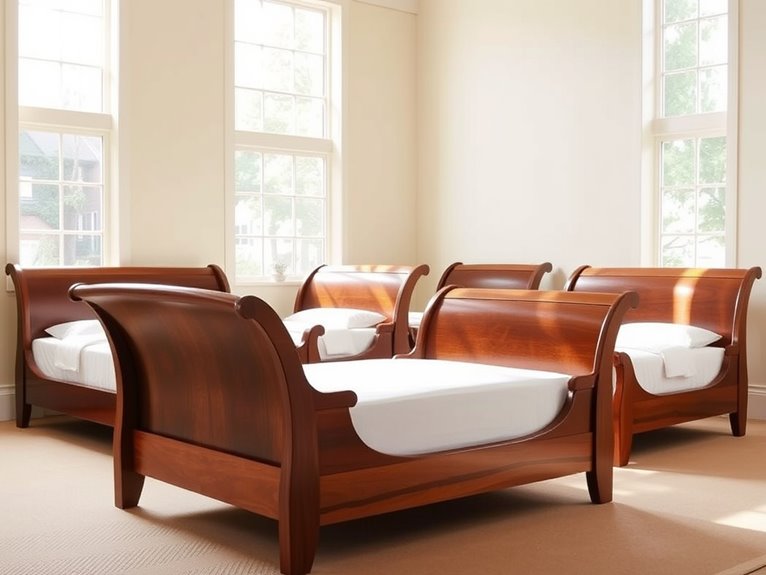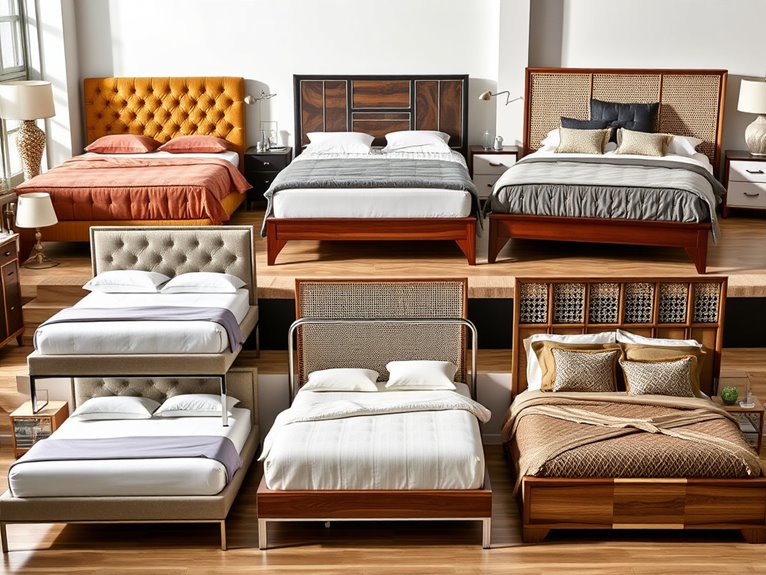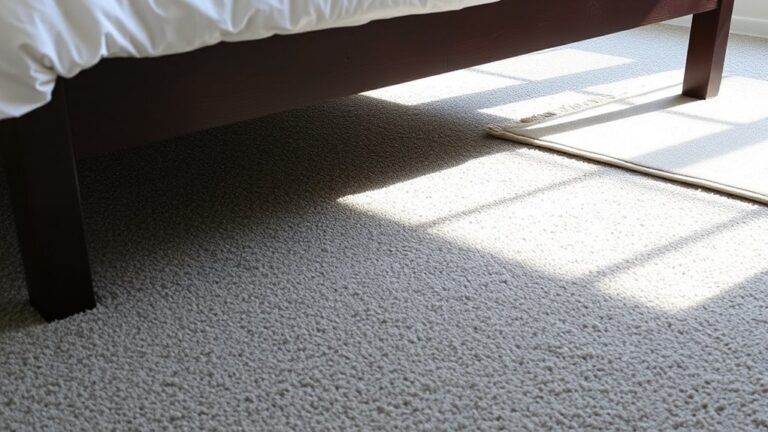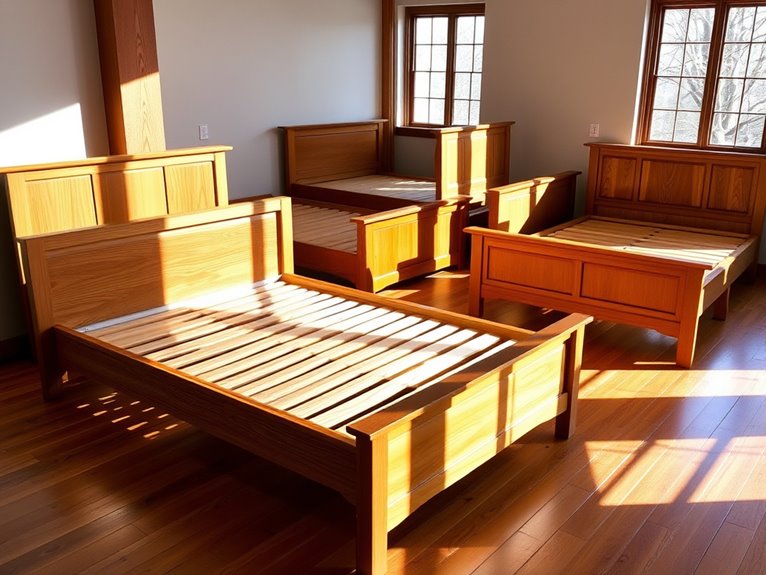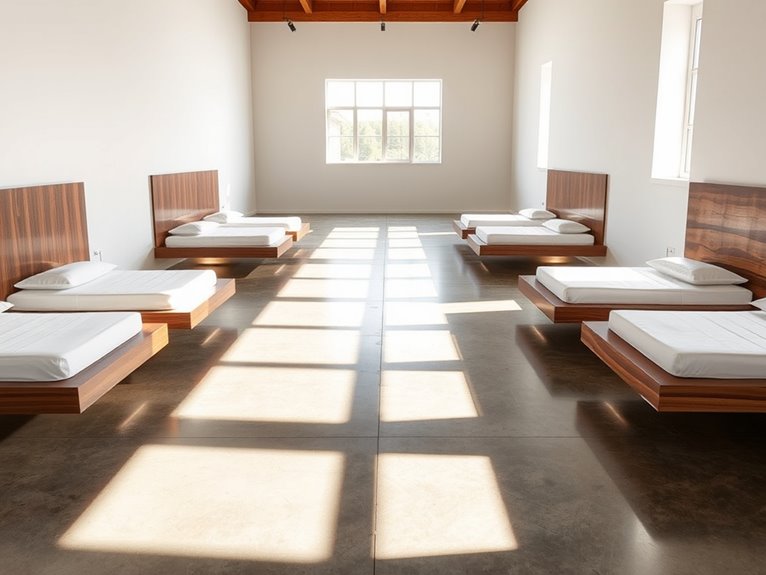5 Curved Wood Beds
Like waves of wood frozen in time, curved bed designs transform ordinary bedrooms into artistic sanctuaries. You’ll discover how these five distinctive styles blend natural materials with flowing forms, creating statement pieces that enhance your space beyond mere functionality. From coastal-inspired sleigh beds to dramatic canopy frames, each design offers unique ways to incorporate organic curves into your bedroom’s aesthetic. Let’s explore how these masterpieces of craftsmanship can elevate your sleeping sanctuary.
The Coastal Wave Sleigh Bed
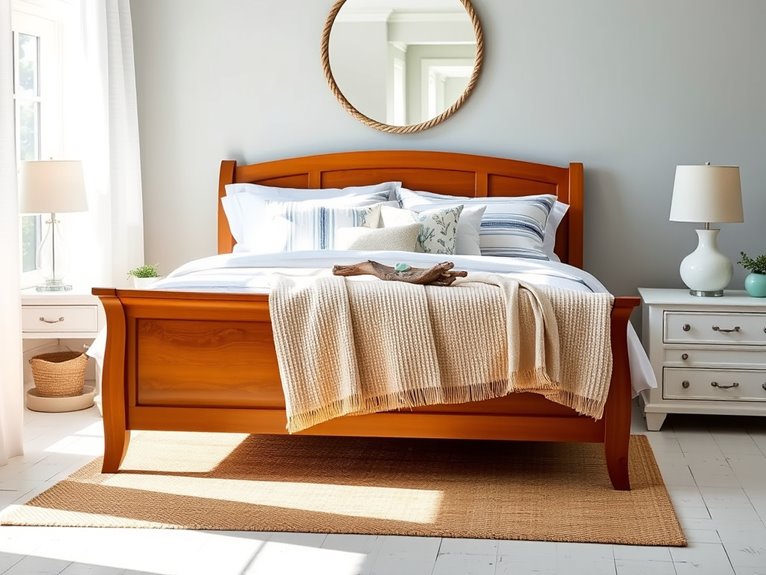
The graceful curves of a sleigh bed take on a distinctly maritime character when styled with coastal-inspired elements, creating a sophisticated yet relaxed aesthetic that mirrors the gentle waves of the ocean. The curved headboard and footboard of the sleigh bed naturally complement the flowing, organic patterns found in coastal decor, while the substantial frame provides an anchor for layers of soft, beach-toned textiles.
This styling technique works particularly well during spring and summer months, though it can create a year-round retreat atmosphere in any bedroom. The style is especially suited for coastal homes, beach houses, or urban spaces seeking to capture seaside serenity. The combination of curved wood elements with airy, light fabrics creates a perfect balance between structure and fluidity.
Essential Components:
- White or cream base sheets
- Blue-striped duvet cover
- Waffle-weave blanket in sandy beige
- Linen pillow shams
- Decorative coastal pillows
- Natural fiber throw
- Glass table lamps
- Seagrass or jute rug
- Driftwood accents
- Sea glass vessels
- White curtain panels
- Picture hooks and hardware
How to Achieve This Look
Begin by dressing the bed with crisp white sheets, tucking them tightly to create clean lines that contrast with the sleigh bed’s curves. Layer a blue-striped duvet cover, folding it back at the top third to create visual interest and reveal the sheets beneath. The stripes should run horizontally to echo the wave-like quality of the bed’s design.
Build the pillow arrangement starting with European shams at the back, followed by standard pillows in crisp white cases. Add decorative pillows in varying sizes and textures, incorporating coastal patterns and colors like coral motifs, nautical stripes, or seafoam green hues. Arrange them in descending size order, with the largest at the back.
Complete the look with carefully chosen accessories that enhance the coastal theme without overwhelming it. Position glass table lamps with clear or sea glass bases on both nightstands. Add natural elements like driftwood pieces or coral specimens to nearby surfaces. The color palette should stick to blues, sandy beiges, soft whites, and gentle grays to maintain the serene coastal atmosphere.
Pro Styling Tips
For maximum impact, keep the wall color light and neutral, allowing the curved lines of the sleigh bed to stand out as a focal point. During winter months, swap lightweight linens for plusher materials in the same coastal palette, and add warm throws in cable-knit textures reminiscent of fisherman sweaters.
In smaller rooms, minimize decorative pillows to three or four key pieces to prevent the bed from feeling overcrowded, and consider using mirrors to reflect light and create the illusion of ocean views. Daily maintenance is simple – keep throws loosely folded at the foot of the bed and limit decorative pillows to those you’ll actually use, storing extras in a nearby basket or chest.
Mid-Century Modern Curved Panel Design
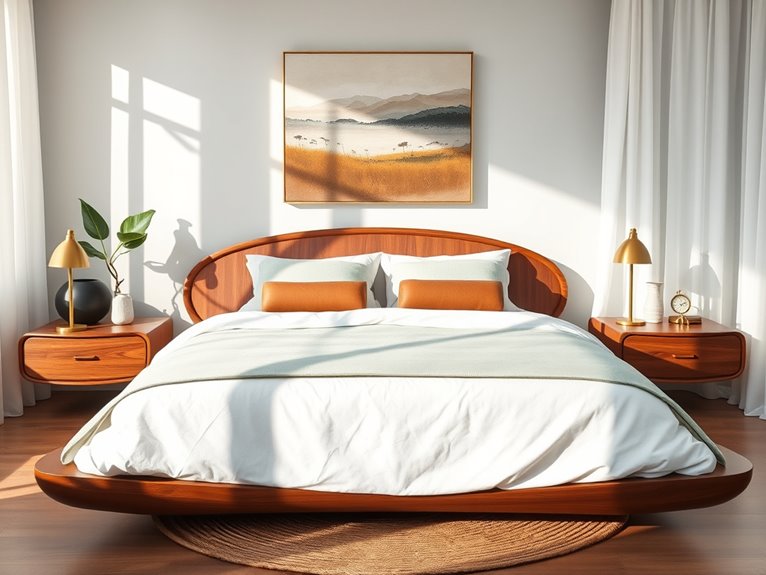
Mid-Century Modern curved panel beds combine sleek lines with organic shapes, creating a harmonious blend of form and function that defined the revolutionary design movement of the 1950s and 60s. The gentle curves of the headboard and footboard panels offer a softer alternative to traditional straight-lined furniture while maintaining the clean, minimalist aesthetic that makes mid-century modern design so timeless and versatile.
This styling technique works particularly well in contemporary urban spaces and modernist-inspired bedrooms where geometric patterns and natural materials create a sophisticated atmosphere. The curved panels serve as an architectural focal point year-round, though the look can be adapted seasonally through textiles and accessories. The style is especially effective in rooms with abundant natural light, as the curves create interesting shadow play throughout the day.
Essential Components:
- Walnut or teak curved panel bed frame
- Low-profile box spring
- Memory foam or hybrid mattress
- Crisp white or neutral-toned sheets
- Geometric patterned duvet cover
- Minimal throw pillows in solid colors
- Brass or wooden bedside lamps
- Abstract wall art
- Natural fiber area rug
- Floating nightstands
- Scandinavian-inspired accessories
How to Achieve This Look:
Begin with positioning the curved panel bed frame as the centerpiece, ideally with equal space on both sides for balanced symmetry. The bed should be placed against the main wall, allowing the curved panels to stand out against a neutral backdrop.
Layer the bedding starting with high-thread-count sheets in white or soft earth tones, followed by a streamlined duvet in complementary colors like sage green, burnt orange, or muted blue.
Select accessories that echo the period’s design principles: clean lines, organic shapes, and functional beauty. Incorporate materials like brass, walnut, and ceramics in bedside accessories. The color palette should remain restrained, focusing on warm woods, neutrals, and one or two accent colors that complement the curved panels without overwhelming them.
Create visual interest through texture rather than pattern. Use natural materials like wool, linen, and cotton in solid colors or subtle weaves. Keep the overall styling minimal, allowing negative space to emphasize the bed’s architectural elements. When photographing the space, capture angles that highlight the curves against straight architectural lines.
Pro Styling Tips:
Maintain the bed’s sophisticated appeal by avoiding excessive pillows or heavy drapery that could compete with the curved panels. For seasonal updates, switch accent pillows and throws while keeping the base neutral; use lighter linens in summer and introduce weighted blankets in winter.
In smaller rooms, float nightstands on the wall to preserve visual flow, and consider mounting sconces instead of table lamps to save space. Keep the bed made with hospital corners and minimal wrinkles to emphasize the clean lines that define mid-century modern style.
Sculptural Bent Wood Platform Frame
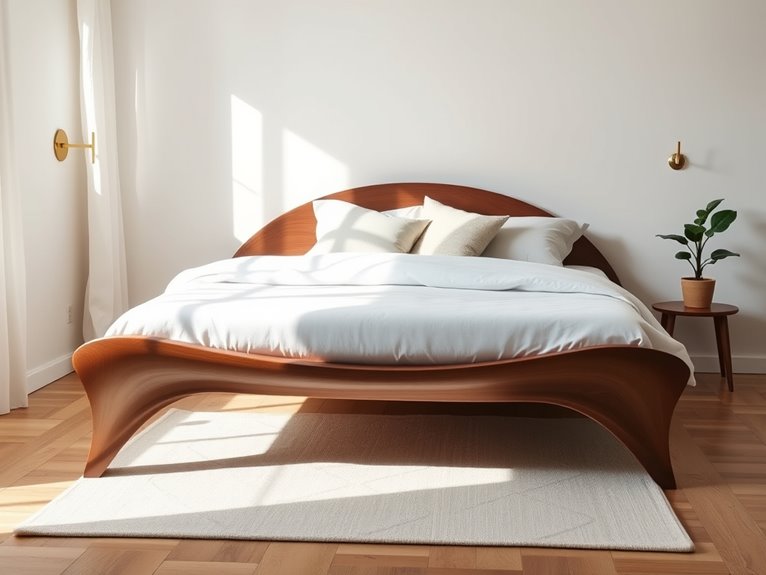
Sculptural bent wood platform frames represent the perfect marriage of organic artistry and functional design, creating a striking focal point that transforms any bedroom into a contemporary sanctuary.
The graceful curves and flowing lines of bent wood construction create an illusion of movement, while the platform design maintains a grounded, sophisticated presence that works particularly well in modern and minimalist spaces.
This styling technique proves especially effective in rooms seeking to balance natural elements with clean architectural lines. The sculptural frame’s organic form makes it ideal for year-round use, though it particularly shines in spring and summer when paired with light, airy textiles.
The style adapts beautifully to both urban lofts and nature-inspired retreats, offering versatility while maintaining its distinctive artistic character.
Essential Components:
- Bent wood platform bed frame
- Low-profile mattress
- Fitted sheet in natural fibers
- Flat sheet in complementary solid color
- Light duvet or coverlet
- 2-4 standard pillows
- 2-3 decorative pillows
- Minimal bedside lighting
- Natural fiber area rug
- Microfiber cleaning cloth
- Wood conditioning oil
- Level tool
How to Achieve This Look
Begin by positioning the bent wood frame as the room’s centerpiece, ensuring proper lighting highlights the sculptural curves.
The platform should be perfectly level to maintain the frame’s intended lines and structural integrity. Select bedding in monochromatic or tonal colors that won’t compete with the frame’s natural beauty – think warm whites, soft grays, or muted earth tones.
Layer bedding with intention, keeping lines clean and minimal. Start with a fitted sheet that hugs the mattress precisely, followed by a flat sheet tucked with hospital corners.
Add a light duvet or coverlet, allowing it to drape naturally over the platform edges without obscuring the frame’s distinctive curves.
For the finishing touches, arrange pillows in a simple, organized manner that echoes the frame’s flowing lines.
Standard pillows should rest against the headboard, while decorative pillows can be placed asymmetrically to create visual interest without overwhelming the design. Natural materials and textures in the surrounding decor will complement the wood’s organic quality while maintaining the modern aesthetic.
Pro Styling Tips
To maximize the impact of a sculptural bent wood frame, keep the surrounding space intentionally minimal – this is one instance where less truly is more.
For smaller rooms, choose lighter wood tones and floating side tables to maintain an airy feel, while larger spaces can handle darker woods and more substantial accompanying pieces.
To protect the wood’s finish and maintain its beauty, regularly dust with a microfiber cloth and apply wood conditioner seasonally, paying special attention to the curved sections where stress points occur.
When styling for photos, capture the frame from multiple angles to highlight the interplay of light and shadow across the curves, and consider shooting during golden hour for optimal natural lighting.
Art Nouveau-Inspired Flowing Lines
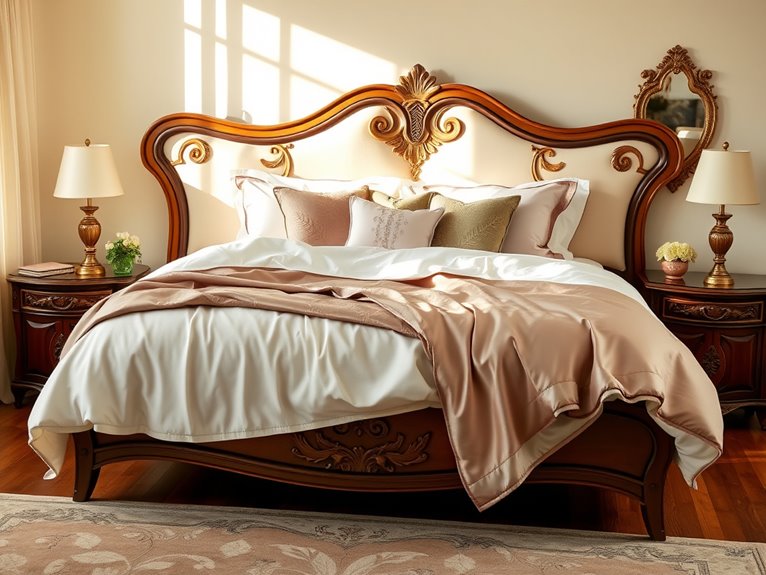
The sinuous, organic curves characteristic of Art Nouveau design create a mesmerizing focal point in bedroom decor when applied to curved wood beds. These flowing lines echo natural forms like unfurling ferns and ocean waves, bringing an ethereal, dreamlike quality to the sleeping space. The curved headboards and footboards, often featuring intricate carved details, transform the bed into a sculptural masterpiece that commands attention while maintaining an elegant, feminine grace.
This styling technique works particularly well in spaces that embrace romantic or artistic aesthetics, especially during spring and summer when the organic forms complement the natural world outside. The curved elements soften angular room architecture and create a sense of movement that guides the eye throughout the space. This approach pairs beautifully with both neutral palettes and rich jewel tones, making it adaptable to various interior design schemes.
Essential Components:
- Curved wood bed frame with decorative carved details
- Silk or satin fitted sheet
- High-thread-count cotton flat sheet
- Flowing duvet cover in solid or subtle pattern
- Multiple Euro shams
- Standard pillow shams
- Decorative accent pillows with curved patterns
- Lightweight throw blanket
- Vintage-inspired table lamps
- Art Nouveau wall art
- Curved mirror
- Fresh flowers or dried botanicals
- Fabric steamer
How to Achieve This Look
Begin by positioning the bed to maximize the visual impact of its curved elements, ideally against a focal wall. Layer the bedding starting with crisp, fitted sheets in ivory or pearl tones, followed by a flat sheet with delicate embroidered details along the edges. The duvet should feature subtle, wave-like patterns or solid colors in muted metallics, dusty roses, or sage greens to complement the wood’s natural tones.
Create depth through strategic pillow arrangement, starting with Euro shams against the headboard, followed by standard pillows in coordinating cases. Add decorative pillows featuring Art Nouveau-inspired patterns or textures, arranging them in a curved formation that mirrors the bed’s flowing lines. The throw blanket should be draped asymmetrically across the foot of the bed, creating gentle waves that echo the overall design theme.
Complete the look by incorporating curved elements throughout the room. Place matching table lamps with curved bases and fabric shades on bedside tables. Hang Art Nouveau prints or mirrors with flowing frames to reinforce the style. Choose metallic accents in brass or copper to add warmth and reflect light, enhancing the room’s organic movement.
Pro Styling Tips
For maximum impact, layer textures rather than patterns to avoid competing with the bed’s intricate details. In smaller rooms, keep the color palette light and consistent to prevent overwhelming the space, and use mirrors strategically to amplify natural light and create the illusion of more space. During warmer months, switch heavy fabrics for lightweight alternatives while maintaining the curved aesthetic through pillow arrangement and accessory choices.
To preserve the bed’s artistic appeal during daily use, invest in high-quality pillows that hold their shape and consider keeping decorative elements minimal Monday through Friday, saving the full styling for weekends and special occasions.
Contemporary Curved Canopy Statement
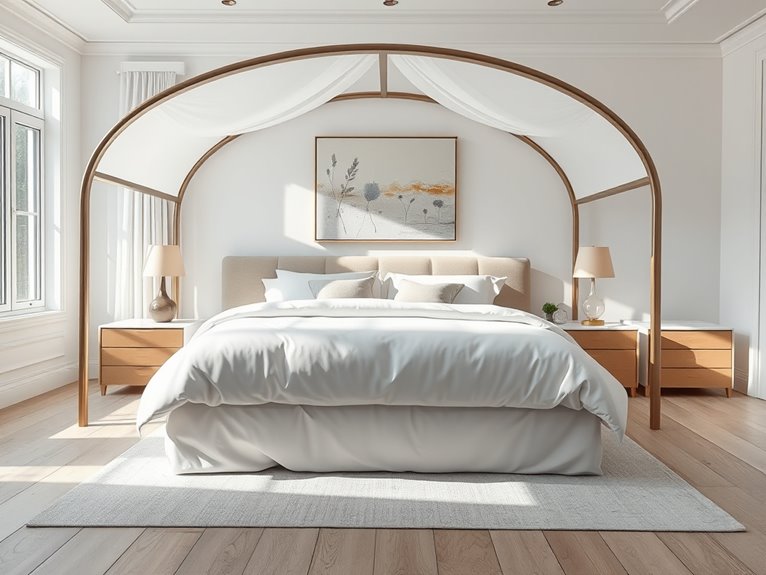
A curved canopy bed creates a dramatic architectural statement while maintaining modern elegance through clean lines and flowing forms. The gentle arc of the canopy frame draws the eye upward, creating an illusion of increased ceiling height while forming an intimate sleeping sanctuary. This bold design choice serves as both a functional sleeping space and a sculptural centerpiece that transforms an ordinary bedroom into a luxurious retreat.
This styling technique works particularly well in contemporary and transitional bedrooms with minimal decoration, allowing the curved structure to take center stage. While perfect for year-round use, it’s especially impactful during winter months when the canopy can be draped with lightweight fabrics for added warmth and ambiance. The style adapts beautifully to both spacious master suites and more modest-sized bedrooms, as the vertical emphasis helps maximize visual space.
Essential Components:
- High-quality curved canopy bed frame
- Crisp white or neutral bedding set
- Fitted sheet
- Flat sheet
- Duvet cover
- Euro shams (2-3)
- Standard pillows (2-4)
- Decorative pillows (3-5)
- Sheer draping fabric panels
- LED strip lighting
- Mounting hardware
- Cable ties or fabric clips
- Steamer for fabric maintenance
How to Achieve This Look
Begin by positioning the curved canopy bed frame as the focal point of the room, ideally centered on the main wall. The frame should be assembled with precision, ensuring all curves are properly aligned and stable. If the canopy includes built-in lighting, install it during assembly to ensure wiring is concealed within the frame.
Layer the bedding starting with crisp, high-thread-count sheets in white or soft neutrals. Add a plush duvet in a complementary tone, focusing on creating clean lines and smooth surfaces. The bedding should be tucked tightly at the corners to maintain the modern aesthetic, while the duvet can be folded back at the top third to create visual interest.
For the canopy draping, select lightweight, semi-sheer fabrics that complement the room’s color scheme. Popular choices include white, ivory, or pale gray for a classic look, or incorporate subtle metallics for added sophistication. Install the fabric panels using proper mounting hardware, ensuring they flow naturally along the curved frame while maintaining symmetry on both sides.
Color combinations that work exceptionally well include white-on-white for a pure, contemporary look; greige and ivory for warm sophistication; or deep charcoal with white for dramatic contrast. When photographing the finished design, capture both full-room shots to showcase the canopy’s architectural impact and detail shots of the fabric’s interaction with light and shadow.
Pro Styling Tips
For maximum impact, incorporate hidden LED strip lighting along the interior of the canopy frame to create a subtle glow effect after dark – a designer secret that adds depth and ambiance.
Scale the amount of draping based on room size: use lighter, more minimal fabric in smaller spaces and fuller draping in larger rooms. To maintain the crisp look during daily use, keep a handheld steamer nearby for quick touch-ups of both the canopy fabric and bedding, and consider using wrinkle-resistant bedding materials to minimize maintenance needs.
